The Remarkable Language of Cells
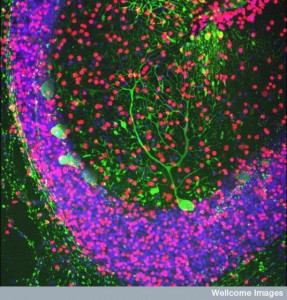 All living creatures communicate, providing group activity and defense. But, it has been surprising to find individual cells, also, have very elaborate communication. Amoebae communication is so complex that individual creatures are able to combine into what appears to be a multi cellular organism and then go back to independent life later. Human cells use thousands of signals to talk to each other, such as cytokines, neurotransmitters, peptides, protein factors, RNAs, as well as electric oscillations and fields.
All living creatures communicate, providing group activity and defense. But, it has been surprising to find individual cells, also, have very elaborate communication. Amoebae communication is so complex that individual creatures are able to combine into what appears to be a multi cellular organism and then go back to independent life later. Human cells use thousands of signals to talk to each other, such as cytokines, neurotransmitters, peptides, protein factors, RNAs, as well as electric oscillations and fields.
Humans build receptors for wireless signals (radios, TVs, cellular phones, and laptops) and send wireless signals (text, telephones and computers). Microbes, T cells, and microglia, also, send and pick up wireless signals using cytokines, neurotransmitters, RNAs, proteins, and electricity. Recent research shows that cells, also, use light photons to communicate. Humans are constantly inundated with electromagnetic signals, but can only pick up the ones for which they have receivers. Microbes, T cells and microglia, also, receive only those messages for which they have built specific protein receptors.
Many previous posts have described cellular signaling—among viruses and bacteria, plant and animal cells. Please refer to the specific posts for the details of each cell type mentioned below.

It is well known how neurons signal with neurotransmitters. These same neurons, also, signal with synchronous waves to far away regions and electrical synapses for cells that are close by. It is not as well known that neurons signal sideways from unmyelinated axons to local immune cells using cytokines and neurotransmitters. Neurons, also, transport large genetic molecules in vesicles and special nanotubes (cytonemes) between cells.
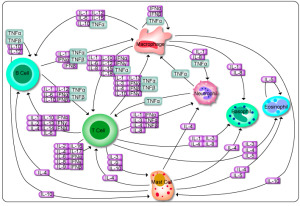
The more numerous glia brain cells—microglia, astrocytes and oligodendrites—use the same elaborate signaling with neurotransmitters, immune cytokines and vesicles for larger molecules and nanotubes. Microglia, astrocytes and T cells, also, communicate by touch.
Immune cells use a very large complex communication system with hundreds of different cytokines and chemokines (a specialized cytokine that specializes in telling cells where to go). Many other cells, such as skin and the intestinal lining cells, also, use similar complex signaling back and forth to trillions of microbes on one side and the immune cells just below.
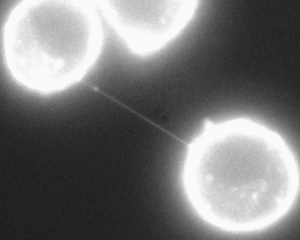
Recently, cells of all types (humans and microbes) have been found to have very small nano tubes communicating with other cells. These cytonemes go travel long distances to transfer molecules, signals and genetic information.
Cytonemes are fragile but can extend the distance of 100 cells. They are just too small to have been noticed until recently, but now appear to be very common.

Round membrane sacs, called vesicles and exosomes, are filled with signal molecules of all kinds—neurotransmitters, proteins with specific functions, and DNA and RNA of all kinds. They are very widely used by almost all microbe, plant and animal cells. They are very much like viruses created by the cells.
Neurons have been observed sending vesicles with proteins, small RNAs and DNA back and forth with glia cells. They have very important effects, such as oligodendrocytes sending heat shock proteins and glycolytic enzymes to protect the neuron from oxidative stress.
There are many different types of vesicles:
Recently, it has been found that cells are able to communicate with photons from cell to cell (called bio photon emissions). Cells can perform this type of communication even through glass, which shows that it is not a molecular communication.

The research used microbes (ciliate Paramecium) in glass vials in the dark. Two different types of glass material allowed different wavelengths of light through—340 nm to long waves and 150nm (UV) to long waves. Cells were able to alter characteristics of nearby cells related to energy and cell division. The two different types of wavelengths resulted in different effects raising the question of different frequencies sending different types of information.
There are a variety of studies that have found some version of this light photon communication in yeast, crustacea, onion roots, and algae. There has, also, been cell-to-cell communication between cultured dying neurons and cancer cells that are separated in different glass containers.
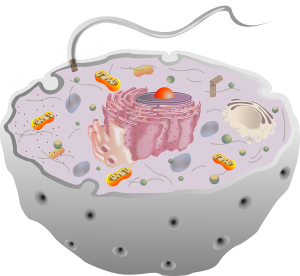
out of cells with large numbers of receptors, and signaling and transport machinery inside.
Primary cilia receive and analyze mechanical and chemical forces and signals. They send signals to other parts of the cell, to other cells, or to the larger organism.
There are many specialized versions of the primary cilium throughout the nervous system, including for hearing, sight and smell. They sense urine flow in kidney cells, light wavelengths in eye cells, pressure in cartilage, and blood flow in heart cells.
Human Cells Communication

The platelet, even without a nucleus, has a surprisingly elaborate communication with other cells. It has many receptors and sends many signals; it is the vital first responder for trauma and inflammation. Platelets track microbes and signal for many different immune cells, stimulating inflammation. They, also, aid T cells and B cells.
Platelets secrete granules with many signals containing:

Platelets signal with all four major chemokine receptor for long distance traveling. They have receptors for immunoglobulins, many pattern receptors and many important cytokines.
Platelets release many unique signals called kinocidins, which are class of large proteins. They signal other immune cell and kill microbes. Kinocidins are unusual in that they can be large full sized proteins or pieces cut by enzymes.
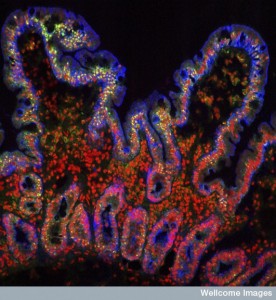
The one layer of cells lining the intestines engages in extremely elaborate communication with the trillions of bacteria on one side and the largest amount of immune cells on the other. This single cell maintains positive and negative interactions with trillions of microbes; it modulates the immune system to accommodate thousands of different microbe communities; it determines digestion of food and production of vitamins. It, also, signals with a large number of cytokines back and forth in both directions.

Intestinal epithelial cells are masters of maintaining order in a very chaotic situation, using a large number of different receptors and secreted signals. In other regions, these same signals would stimulate major inflammation because they do not expect a large amount of microbes. But, here the epithelial cell determines the strength of the signals and what response should occur.
Microbes signal to these cells for protection, but this can possibly increase cancer. So, the epithelial cell must maintain a very delicate balance. Signals to T cells either increase the immune presence or decrease it. Messages tell T cells to be tolerant or not.

The skin epithelial cell, just like the intestinal cell, has trillions of microbes on one side and a large number of immune cells on the other.Like the intestinal cells they have very complex relations with bacteria and immune cells. They decide responses to toxins and injuries from the outside world. The keratinocyte gradually undergoes modification as it moves to the outer layers where it develops more receptors.
Skin cells have very extensive back and forth conversations with immune cells, microbes and the connective cells that make up the barrier. They determine the friendly microbes from unfriendly by signaling and determine which are allowed to stay on the surface. They are extremely active in calling for very specific immune cells when needed, using a language of hundreds of different cytokines and chemokines. They, also, have their own memory of immune history and the defenses related to specific microbes.

Most cells that are not immune cells, also, have elaborate communication related to defense of microbe attacks. Cells produce many specific substances to call for help and to fight specific microbes. Interestingly, different neurons in different regions have developed different signals and attack molecules.
Three genes stimulated by interferon, (a factor produced by immune cells responding to an intrusion of an invader) trigger different approaches to fighting viruses in two kinds of brain cells. In these two different neurons, there are also differences in epigenetic markings and different microRNAs involved in the process of fighting the virus. It appears that each of these neurons evolved different mechanisms to fight the same virus.
There are many other examples of ordinary cells communicating. One example involves bone. Two types of cells, mesenchymal and cartilage, signal back and forth to determine the amount of bone that will grow on the cartilage. Mesenchyme signals limit the genes that make cartilage by modifying the gene and the histone. Another signal protects the cartilage growth.

Mitochondria are microbes that travel throughout neurons (and all other cells) keeping in close contact with the needs of the neuron. They communicate by docking near the endoplasmic reticulum and through cytokine signaling.
Mitochondria make essential energy for all processes including movement and recycling of neurotransmitter vesicles, assembly and movement of the scaffolding tubules, generation of electric charge in axons and dendrites, and maintenance of synaptic neuroplasticity. They regulate the calcium levels in the cell, which trigger axon signal firing and regulate apoptosis, whereby a cell is systematically dismantled without forming scars.
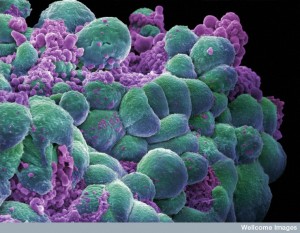
Cancer cell communication is unique in that they use all of the signals that human cells use, but, also, like microbes, defend their own community against other cells in the organism. Cancer cells use the same techniques that T cells and microbes use to rapidly change their metabolism. All three use their basic metabolic cycles, like the Krebs cycle, as communication signals to avoid challenges to rapid replication.
Many non-cancerous cells cooperate with cancers because of back and forth communication. Cancer cells are able to signal to structural cells like fibroblasts and blood vessel cells to build the cancer organ. Immune cells are fooled to give cancer growth factors behaving as if they were healing a wound. These chemokine signals activate receptors on blood vessels, which make them leaky.
Cancers have the same inter community chatter as microbes. Just as plants and microbes defend together against viruses, cancer cells signal to other cancer cells to protect against viruses.
Special Brain And Immune Cell Communication
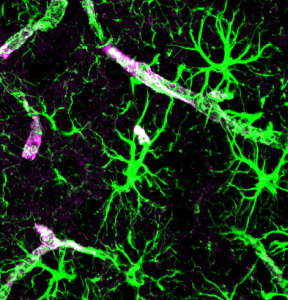
Previous posts have elaborated on the critical work of astrocytes in producing, maintaining, and pruning synapses. They, also, control the blood flow.
Astrocytes use a large vocabulary of neurotransmitters, factors and cytokines to constantly communicate with the thousands of neurons they are in contact with, as well as microglia and other immune cells.
Astrocytes make up half of the brain and are much greater in number than neurons. They have a huge scaffolding sending signals to neurons that are critical to the function of neuroplasticity. Astrocyte signals use calcium fluctuations, not sodium and potassium as in neurons.
They communicate in a language of secreted factors that are absolutely necessary for brain function:
Astrocytes communicate, also, by touching neurons. They control when signals will go out to microglia to eliminate synapses, as well as many signals to immune cells. They attract the complement system.
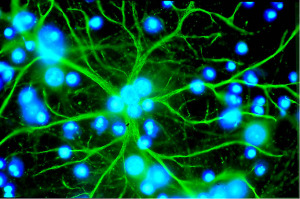
Astrocyte calcium oscillations are extremely complex signals that are just now being researched. Along each arm of the astrocyte there are many different compartments that have diverse types of signaling to the adjacent neurons. Different types of neuroplasticity are stimulated by different types of calcium signaling from the astrocyte compartments lying near the synapses.
Different types of neurons are involved in different astrocyte signaling. Astrocytes can bridge the many different neuroplasticity mechanisms in the large circuits since they receive information from thousands of synapses at once.

Neuronal activity can, independently, create all of the original symptoms of inflammation—fever, redness, heat, and pain. This type of neuroinflammation is not based on response to microbes or injury. There are a large number of different immune and brain cells that signal back and forth stimulating this activity. Neurons use these complex pathways for different types of neuroplasticity.
Neurons trigger major inflammation in response to immune triggers, and “para-inflammation”, a subdued version to use in neuroplasticity. They can be triggered by the naked unmyelated axons, or segments of axons, with sideways local communication.
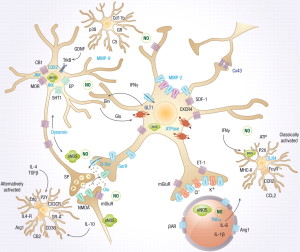
Back and forth communication between neurons and immune cells is very complex, often involving signaling with a language of hundreds of different signals between large numbers of different kinds of cells.
The neuro inflammation synapse includes pre and post synaptic neurons, astrocytes, microglia, T cells, endothelial (vessel lining) cells, macrophages and many other immune cells. With injury, microglia or platelets are the first responders. Both cells alter metabolism and shape; they multiply and start signaling. Astrocytes and T cells are rapidly involved. When neurons become involved, they secrete many other cytokines and chemokines. Extra cellular particles are secreted, which attract even more cellular signals.
There are so many different signals, that just to give some awareness of the complexity the following are some of the signals in this situation.

T cells communicate in many different ways and in different situations. They use a vast amount of cytokine communication with other immune cells; they communicate using cell-to-cell contact to many different immune cells, including directly helping B cells perfect antibodies. They are raised in the thymus, where they are trained to build many different receptors and signals. They are sensitive to each pattern brought to them and respond in many different ways. Also, IL-4 stimulates more BNDF from astrocytes to stimulate more neurons.
When T cells travel in the cerebral spinal fluid of the brain, they send wireless signals to the neurons to maintain cognition and learning. When they determine that there is an invader, T cells will shift to signal the brain to start the “sick feeling”, which lowers cognition and prepares the body to fight off an infection.
T cells secrete cytokines for and against inflammation in different situations.

Microglia travel in a region communicating by tapping all neuronal and astrocyte structures. Their wireless communication to neurons and astrocytes determines how many brain cells are produced and discarded. Through both touching and signaling they find synapses that need pruning.
They have many different receptors and pick up signals from brain and immune cells of all types. Signals can cause inflammation or stop it. They communicate with complement also, the only cell with such receptors. They use MHC at times. They have a very large vocabulary of signals to all types of immune and brain cells.

It was thought until recently that myelin was just an insulator to make signals along axons faster. While it does make communication faster where it is necessary, new information reveals much greater complexity in the ways neurons use myelin.
Neurons maintain different patterns of unmyelinated regions in different regions of the cortex, specifically to communicate with local immune cells, glia cells and regional tissue cells for specific purposes. This sideways communication from the naked axon can be with cytokines and neurotransmitters. In addition the electrical field potential, along with the shape of cells, the extracellular matrix and calcium spikes play a role in this very complex communication.

[url=http://jonlieffmd.com/blog/ http://jonlieffmd.com/blog/brain-electricity-and-the-mind]Different forms of electricity are used for communication between cells.[/url] A recent example shows that color information is signaled with beta waves between two brain regions and orientation with the same beta but between different neurons.
Electrical synapses are critical to brain function with all synaptic structures first modeled in the fetus as electrical synapses and then physically built as chemical receptors. With regeneration later in life electrical synapses first create the linkages. Electrical synapses can trigger synchronous waves and can cause currents in the extracellular medium affecting synapses and neuroplasticity.
Other electrical communication occurs through calcium spikes, action potentials, and the after potential of the spike. Electric potentials, gradients and fields all communicate information such as the structure of the embryo, the shape of organs and limbs.
Plant Communication

Plants communicate by touch, chemicals, roots, air, wires created by fungus and either sound or magnetism. Plants respond to chemicals, contact, pressure, sound, gravity, light and possibly magnetism. Dodder plants communicate with genetic material. See other plant posts for details. Some details include:
Microbes
Many posts have described the elaborate signaling between microbes.

Bacteria have specialized sensors in a honeycomb pattern all over the membrane. Each of the thousand receptors has extreme chemical sensitivity and triggers proteins and cascades of enzymes with responses.
Microbes secrete signals that can immobilize other cells, kill or eat prey or form a large community, such as a biofilm. Microbes integrate multiple sensors, such as chemicals, temperature and touch. Regulation of even small microbes involves hundreds, or thousands, of different one step and two-step receptors, information particles, regulators, modulators and molecular cascades. These processes use genetic stimulation and alteration of protein shapes. The microbe integrates global signals such as sources of nutrients like carbon, but, also specifically what it needs, through hundreds of signaling pathways.
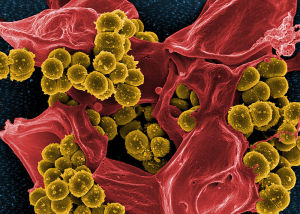
From Jacopo Werther
Microbes communicate by injecting proteins into a cell through various secretory mechanisms. Some of these look like phage viruses or a syringe. In fact, bacteria make viruses to send messages. These proteins have a wide range of effects inside the cell including altering the scaffolding; altering membranes and the signaling from the membranes; altering the tagging systems that allow the cell to destroy microbes; and direct alteration of DNA function to change proteins inside the cell. In clinical settings, they send plasmids (circular DNA) that causes antibiotic resistance.
Human cells engage in intelligent warfare with microbes—both using the tagging system of ubuiqutin. They are, also, able to send signals with specially produced RNAs. They use many cytokine signals with skin, intestine and immune cells.
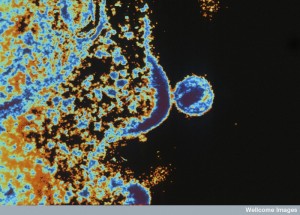
When bacteria travel to a new space, their personal viruses protect them. Some viruses will only attack bacteria they were not born in. Viruses give bacteria toxins to fight other enemy bacteria; they give genes that enable bacteria to fight against antibiotics; and they give plants genes that enable them to handle drought, heat and cold.
Mucous is an important buffer zone between trillions of possibly dangerous bacteria and the intestinal lining cell. Through signaling, friendly protective bacteria and fungi are allowed to live there and fight dangerous microbes.
Viruses can use the machinery of the cell to create toxins or antitoxins, for back and forth communication and attacks.
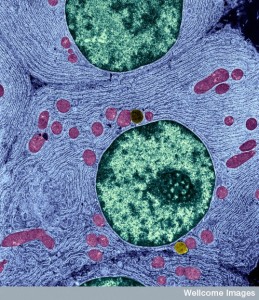
This post contains an outline of a large amount of information. For the details of each type of communication, please see the posts that are linked.
All cells demonstrate a very high degree of intelligence in their communication with other cells. There are a remarkable amount of different ways that they communicate: touching, cytokines, neurotransmitters, RNAs, peptides, genes, kinocidins, hormones, vesicles, photons, electricity, and nanotubes. Communication can involve hundreds of different signals back and forth.
It is difficult to imagine how cells can do this without a version of mind in each cell.
http://jonlieffmd.com/blog/the-remarkable-language-of-cells

Humans build receptors for wireless signals (radios, TVs, cellular phones, and laptops) and send wireless signals (text, telephones and computers). Microbes, T cells, and microglia, also, send and pick up wireless signals using cytokines, neurotransmitters, RNAs, proteins, and electricity. Recent research shows that cells, also, use light photons to communicate. Humans are constantly inundated with electromagnetic signals, but can only pick up the ones for which they have receivers. Microbes, T cells and microglia, also, receive only those messages for which they have built specific protein receptors.
Many previous posts have described cellular signaling—among viruses and bacteria, plant and animal cells. Please refer to the specific posts for the details of each cell type mentioned below.
All Cells Communicate in Many Ways


Immune cells use a very large complex communication system with hundreds of different cytokines and chemokines (a specialized cytokine that specializes in telling cells where to go). Many other cells, such as skin and the intestinal lining cells, also, use similar complex signaling back and forth to trillions of microbes on one side and the immune cells just below.
Nanotubes Between Cells – Cytonemes

Recently, cells of all types (humans and microbes) have been found to have very small nano tubes communicating with other cells. These cytonemes go travel long distances to transfer molecules, signals and genetic information.
Cytonemes are fragile but can extend the distance of 100 cells. They are just too small to have been noticed until recently, but now appear to be very common.
Vesicle Communication

Neurons have been observed sending vesicles with proteins, small RNAs and DNA back and forth with glia cells. They have very important effects, such as oligodendrocytes sending heat shock proteins and glycolytic enzymes to protect the neuron from oxidative stress.
There are many different types of vesicles:
- Vacuole Vesicles: for plant cells to store food

Secretion Vesicles: neurotransmitters, hormones and material for extra cellular matrix.- Lysosomes: for waste disposal with enzymes to break down molecules
- Transport Vesicles: transporting material inside the cell, compartment to compartment; from endoplasmic
reticulum to other sites; into blood.
- Gas Vesicles: control microbe gas content for positioning for light or movement.
- Extra cellular matrix vesicles: calcium, phosphate, lipids and necessary proteins to build bone matrix.
- Microbes transfer material: they make their own
viruses and use injection mechanisms like phage viruses.
- Viruses: sacs with material transferring genetic information
- Neuronal vesicles: secrete and pick up prions
Communication with Light Photons
Recently, it has been found that cells are able to communicate with photons from cell to cell (called bio photon emissions). Cells can perform this type of communication even through glass, which shows that it is not a molecular communication.

The research used microbes (ciliate Paramecium) in glass vials in the dark. Two different types of glass material allowed different wavelengths of light through—340 nm to long waves and 150nm (UV) to long waves. Cells were able to alter characteristics of nearby cells related to energy and cell division. The two different types of wavelengths resulted in different effects raising the question of different frequencies sending different types of information.
There are a variety of studies that have found some version of this light photon communication in yeast, crustacea, onion roots, and algae. There has, also, been cell-to-cell communication between cultured dying neurons and cancer cells that are separated in different glass containers.
Communication using RNA
Most cells make many varieties of microRNAs that influence cell functions. They send them in exosomes (vesicles) to influence an entire class of cells. These RNAs reprogram cells and can greatly influence an entire function in an organism.Primary Cilia – Center of Communication
Primary Cilia exist in all cells (microbes, plants and animal) and, although not widely known, are the center of communication with other cells. It is a stationary organ sticking
Primary cilia receive and analyze mechanical and chemical forces and signals. They send signals to other parts of the cell, to other cells, or to the larger organism.
There are many specialized versions of the primary cilium throughout the nervous system, including for hearing, sight and smell. They sense urine flow in kidney cells, light wavelengths in eye cells, pressure in cartilage, and blood flow in heart cells.
Human Cells Communication
Platelet Communication

Platelets secrete granules with many signals containing:
- δ- contain molecules that regulate blood flow with nucleotides such as ADP; amines histamine and serotonin; and ions Ca2 and PO3-.
- α- contain many different proteins and enzymes that attach and kill microbes.
- λ- contain lysosomal vesicles with enzymes altering shape of clot for healing.

Platelets release many unique signals called kinocidins, which are class of large proteins. They signal other immune cell and kill microbes. Kinocidins are unusual in that they can be large full sized proteins or pieces cut by enzymes.
Intestine Epithelial Cell


Microbes signal to these cells for protection, but this can possibly increase cancer. So, the epithelial cell must maintain a very delicate balance. Signals to T cells either increase the immune presence or decrease it. Messages tell T cells to be tolerant or not.
The Skin Cell

Skin cells have very extensive back and forth conversations with immune cells, microbes and the connective cells that make up the barrier. They determine the friendly microbes from unfriendly by signaling and determine which are allowed to stay on the surface. They are extremely active in calling for very specific immune cells when needed, using a language of hundreds of different cytokines and chemokines. They, also, have their own memory of immune history and the defenses related to specific microbes.
Ordinary Cells

Three genes stimulated by interferon, (a factor produced by immune cells responding to an intrusion of an invader) trigger different approaches to fighting viruses in two kinds of brain cells. In these two different neurons, there are also differences in epigenetic markings and different microRNAs involved in the process of fighting the virus. It appears that each of these neurons evolved different mechanisms to fight the same virus.
There are many other examples of ordinary cells communicating. One example involves bone. Two types of cells, mesenchymal and cartilage, signal back and forth to determine the amount of bone that will grow on the cartilage. Mesenchyme signals limit the genes that make cartilage by modifying the gene and the histone. Another signal protects the cartilage growth.
Mitochondria Communicate With Neuron

Mitochondria make essential energy for all processes including movement and recycling of neurotransmitter vesicles, assembly and movement of the scaffolding tubules, generation of electric charge in axons and dendrites, and maintenance of synaptic neuroplasticity. They regulate the calcium levels in the cell, which trigger axon signal firing and regulate apoptosis, whereby a cell is systematically dismantled without forming scars.
Cancer Cell Communication

Many non-cancerous cells cooperate with cancers because of back and forth communication. Cancer cells are able to signal to structural cells like fibroblasts and blood vessel cells to build the cancer organ. Immune cells are fooled to give cancer growth factors behaving as if they were healing a wound. These chemokine signals activate receptors on blood vessels, which make them leaky.
Cancers have the same inter community chatter as microbes. Just as plants and microbes defend together against viruses, cancer cells signal to other cancer cells to protect against viruses.
Special Brain And Immune Cell Communication
Astrocytes Signaling

Astrocytes use a large vocabulary of neurotransmitters, factors and cytokines to constantly communicate with the thousands of neurons they are in contact with, as well as microglia and other immune cells.
Astrocytes make up half of the brain and are much greater in number than neurons. They have a huge scaffolding sending signals to neurons that are critical to the function of neuroplasticity. Astrocyte signals use calcium fluctuations, not sodium and potassium as in neurons.
They communicate in a language of secreted factors that are absolutely necessary for brain function:
- Apolipoprotein E, bound to cholesterol, stimulates synapses and stimulates the vesicles that carry the neurotransmitters to be released at the synapse.
- Thrombospondins are large proteins critical for forming excitatory synapses, adhesion and scaffolding for the synapse.
- Hevin is critical in adult brain synapse formation and maintenance.
- Glypicans stimulate AMPA and NMDA receptors for function of excitatory neurons.
- Ephrins stimulate synapses and neuronal stem cells
Astrocytes communicate, also, by touching neurons. They control when signals will go out to microglia to eliminate synapses, as well as many signals to immune cells. They attract the complement system.

Different types of neurons are involved in different astrocyte signaling. Astrocytes can bridge the many different neuroplasticity mechanisms in the large circuits since they receive information from thousands of synapses at once.
Neurons Communicate Using Inflammation Pathways

Neurons trigger major inflammation in response to immune triggers, and “para-inflammation”, a subdued version to use in neuroplasticity. They can be triggered by the naked unmyelated axons, or segments of axons, with sideways local communication.
Chronic Pain A Conversation of Immune and Brain Cells

The neuro inflammation synapse includes pre and post synaptic neurons, astrocytes, microglia, T cells, endothelial (vessel lining) cells, macrophages and many other immune cells. With injury, microglia or platelets are the first responders. Both cells alter metabolism and shape; they multiply and start signaling. Astrocytes and T cells are rapidly involved. When neurons become involved, they secrete many other cytokines and chemokines. Extra cellular particles are secreted, which attract even more cellular signals.
There are so many different signals, that just to give some awareness of the complexity the following are some of the signals in this situation.
- Presynaptic Neuron: glutamate, CCL2, IFNg, IL-1B, ROS, TNF, receptors TRPV1, TRPA1, IL-1R1, NMDAR
- Astrocyte: IL-1b, TNF, EEAT1, EAAT2, CXCL1, IL-6,
- Inhibitory Neuron: IL-1B, IL-6, ROS, TNF, GABA, Glycine,
- T Cell and Microglia: BDNF, CCL2, IFNg, IL-1B, IL-6, IL-17, PGE2, ROS, TNF
- Post synaptic neuron: TRKB, BDNF, KCC2, IL-1R1, GRK2, PGE2, PKA, ERK, CREB, EP2, GABAR, GlyR3, IL- 1B, NR2A, NR2B, NR1, NMDAR, IL-17, ROS, CCL2, AMPAR, TNFR1, CXCL1, CXCR2, CCR2
T Cell Communication

When T cells travel in the cerebral spinal fluid of the brain, they send wireless signals to the neurons to maintain cognition and learning. When they determine that there is an invader, T cells will shift to signal the brain to start the “sick feeling”, which lowers cognition and prepares the body to fight off an infection.
T cells secrete cytokines for and against inflammation in different situations.
Microglia Communication

They have many different receptors and pick up signals from brain and immune cells of all types. Signals can cause inflammation or stop it. They communicate with complement also, the only cell with such receptors. They use MHC at times. They have a very large vocabulary of signals to all types of immune and brain cells.
[url=http://jonlieffmd.com/blog/ http://jonlieffmd.com/blog/new-myelin-code-adds-to-brain-complexity]Oligodendytes Talk with Neurons About Myelin[/url]

Neurons maintain different patterns of unmyelinated regions in different regions of the cortex, specifically to communicate with local immune cells, glia cells and regional tissue cells for specific purposes. This sideways communication from the naked axon can be with cytokines and neurotransmitters. In addition the electrical field potential, along with the shape of cells, the extracellular matrix and calcium spikes play a role in this very complex communication.
Brain Communication with Electricity

Electrical synapses are critical to brain function with all synaptic structures first modeled in the fetus as electrical synapses and then physically built as chemical receptors. With regeneration later in life electrical synapses first create the linkages. Electrical synapses can trigger synchronous waves and can cause currents in the extracellular medium affecting synapses and neuroplasticity.
Other electrical communication occurs through calcium spikes, action potentials, and the after potential of the spike. Electric potentials, gradients and fields all communicate information such as the structure of the embryo, the shape of organs and limbs.
Plant Communication

- Plants monitor far red.
- Dodder tastes nutrients.
- Chili bean plants signal with either sound or magnetism to warn of the presence of the competitive fennel.
- Fruits signal others to increase ripening.
- Fungal wires between plants go for miles and
send nutrients and information in forests. Plants
can encourage the wires or cut them off if
threatened. Signals along fungal wires warn plants of predators.
- Microbes and Fungus have back and forth elaborate signaling to cooperate in building nitrogen factories. Special “calcium signaling” provides path for microbes to follow into the plant.
- Mechanical force of a single fungus cell is registered by the plant as a signal.
- Plants and microbes self edit DNA/RNA to build attack proteins, and microRNA and siRNA; plants make a large family of R (resistance) proteins like human antibodies.
- Dodder uses horizontal gene transfer of genetic material to manipulate other plants
Microbes
Many posts have described the elaborate signaling between microbes.

Microbes secrete signals that can immobilize other cells, kill or eat prey or form a large community, such as a biofilm. Microbes integrate multiple sensors, such as chemicals, temperature and touch. Regulation of even small microbes involves hundreds, or thousands, of different one step and two-step receptors, information particles, regulators, modulators and molecular cascades. These processes use genetic stimulation and alteration of protein shapes. The microbe integrates global signals such as sources of nutrients like carbon, but, also specifically what it needs, through hundreds of signaling pathways.

From Jacopo Werther
Microbes communicate by injecting proteins into a cell through various secretory mechanisms. Some of these look like phage viruses or a syringe. In fact, bacteria make viruses to send messages. These proteins have a wide range of effects inside the cell including altering the scaffolding; altering membranes and the signaling from the membranes; altering the tagging systems that allow the cell to destroy microbes; and direct alteration of DNA function to change proteins inside the cell. In clinical settings, they send plasmids (circular DNA) that causes antibiotic resistance.
Human cells engage in intelligent warfare with microbes—both using the tagging system of ubuiqutin. They are, also, able to send signals with specially produced RNAs. They use many cytokine signals with skin, intestine and immune cells.
Viruses Positive and Negative Communication with Bacteria

Mucous is an important buffer zone between trillions of possibly dangerous bacteria and the intestinal lining cell. Through signaling, friendly protective bacteria and fungi are allowed to live there and fight dangerous microbes.
Viruses can use the machinery of the cell to create toxins or antitoxins, for back and forth communication and attacks.
The Remarkable Language of Cells

All cells demonstrate a very high degree of intelligence in their communication with other cells. There are a remarkable amount of different ways that they communicate: touching, cytokines, neurotransmitters, RNAs, peptides, genes, kinocidins, hormones, vesicles, photons, electricity, and nanotubes. Communication can involve hundreds of different signals back and forth.
It is difficult to imagine how cells can do this without a version of mind in each cell.
http://jonlieffmd.com/blog/the-remarkable-language-of-cells


